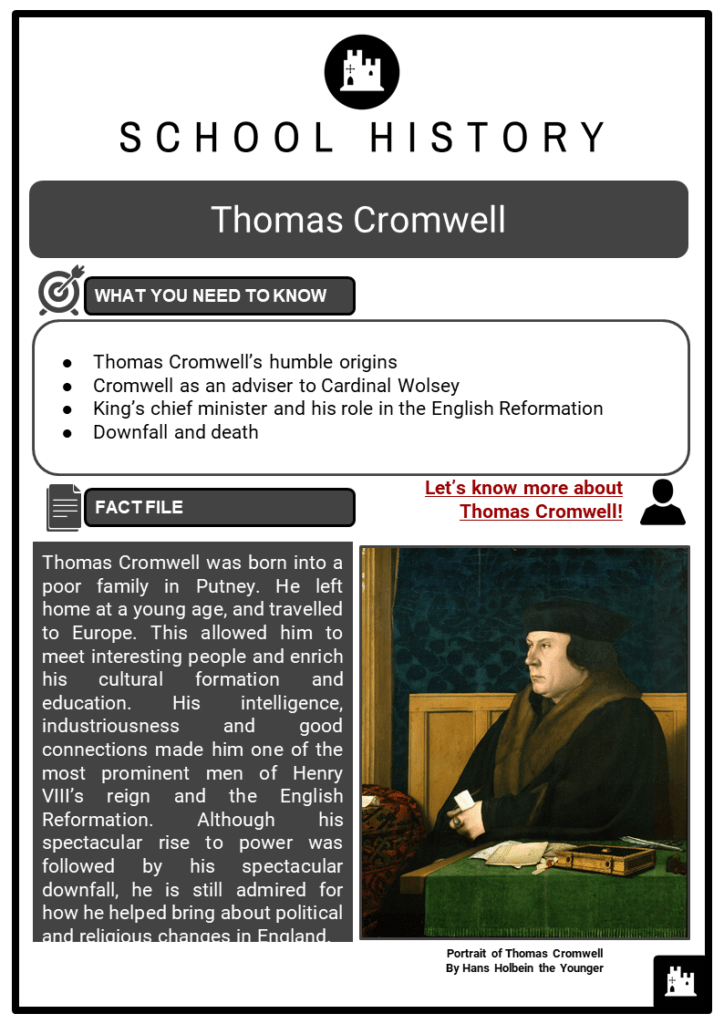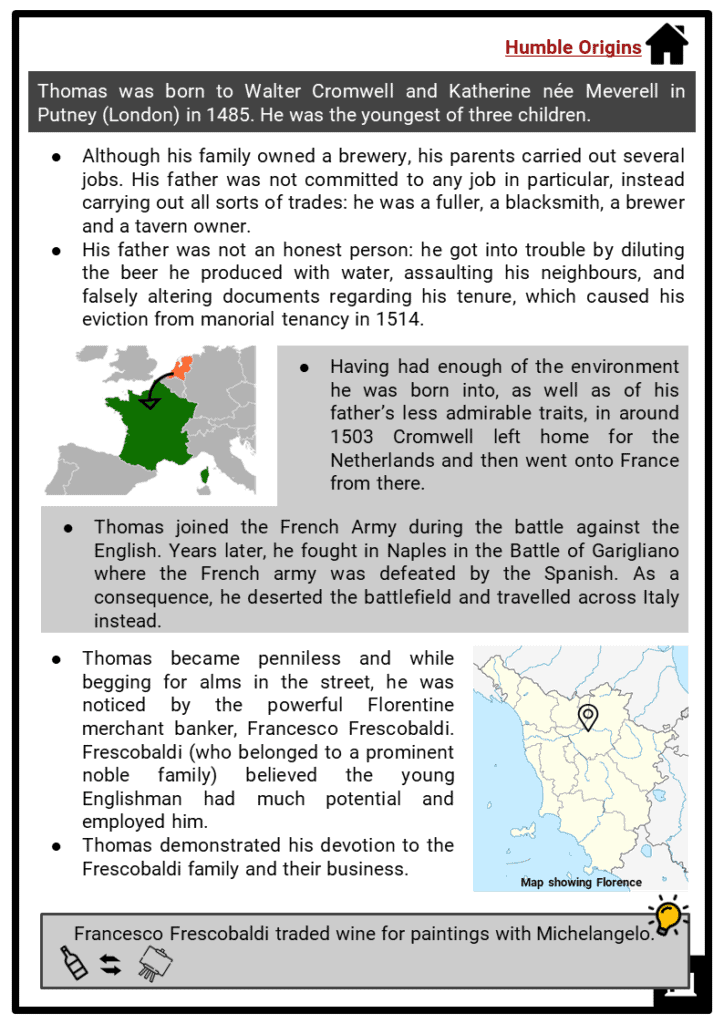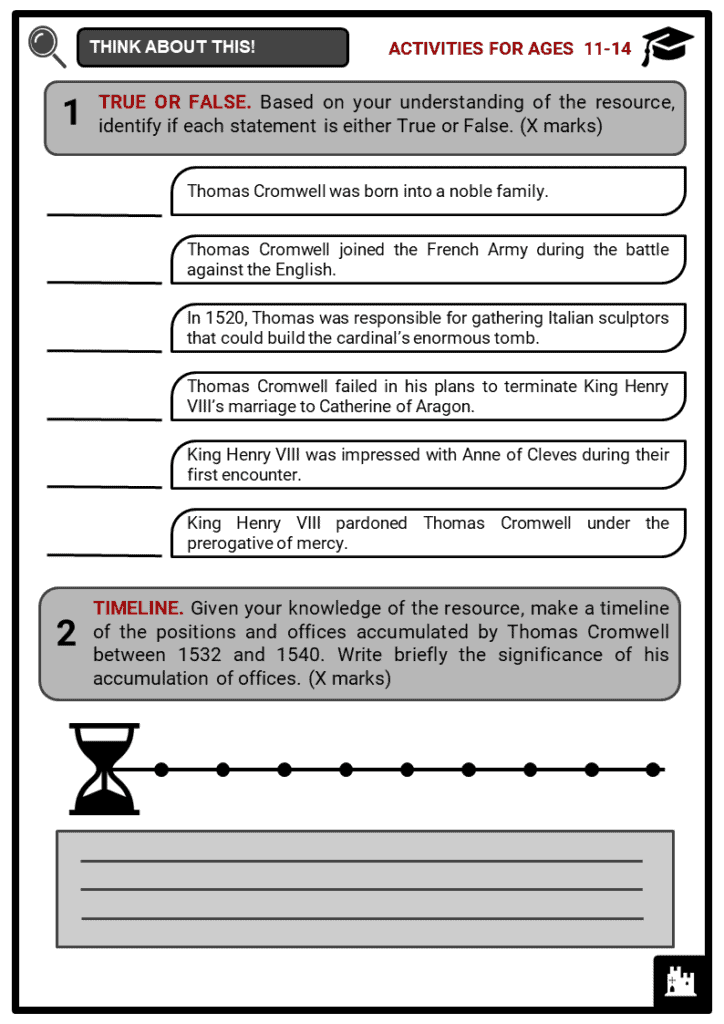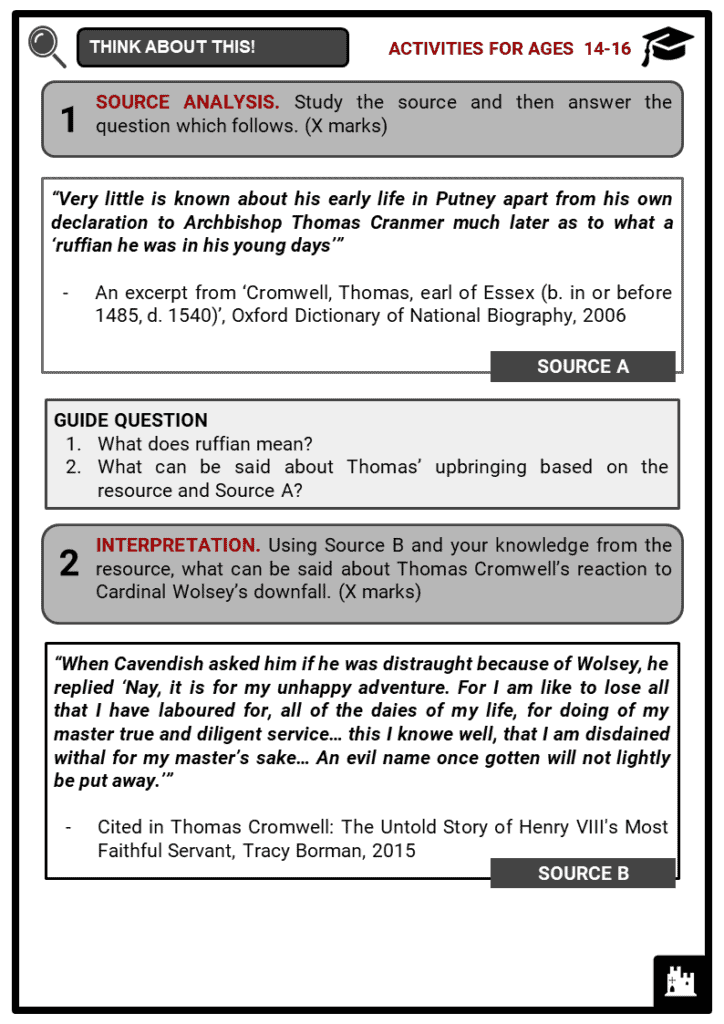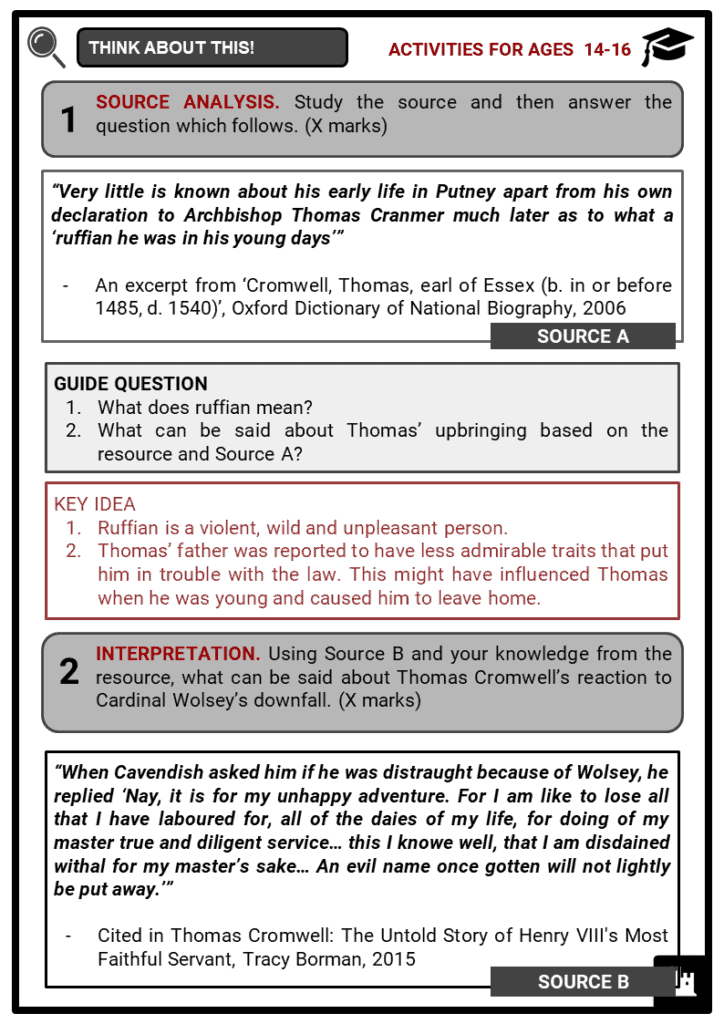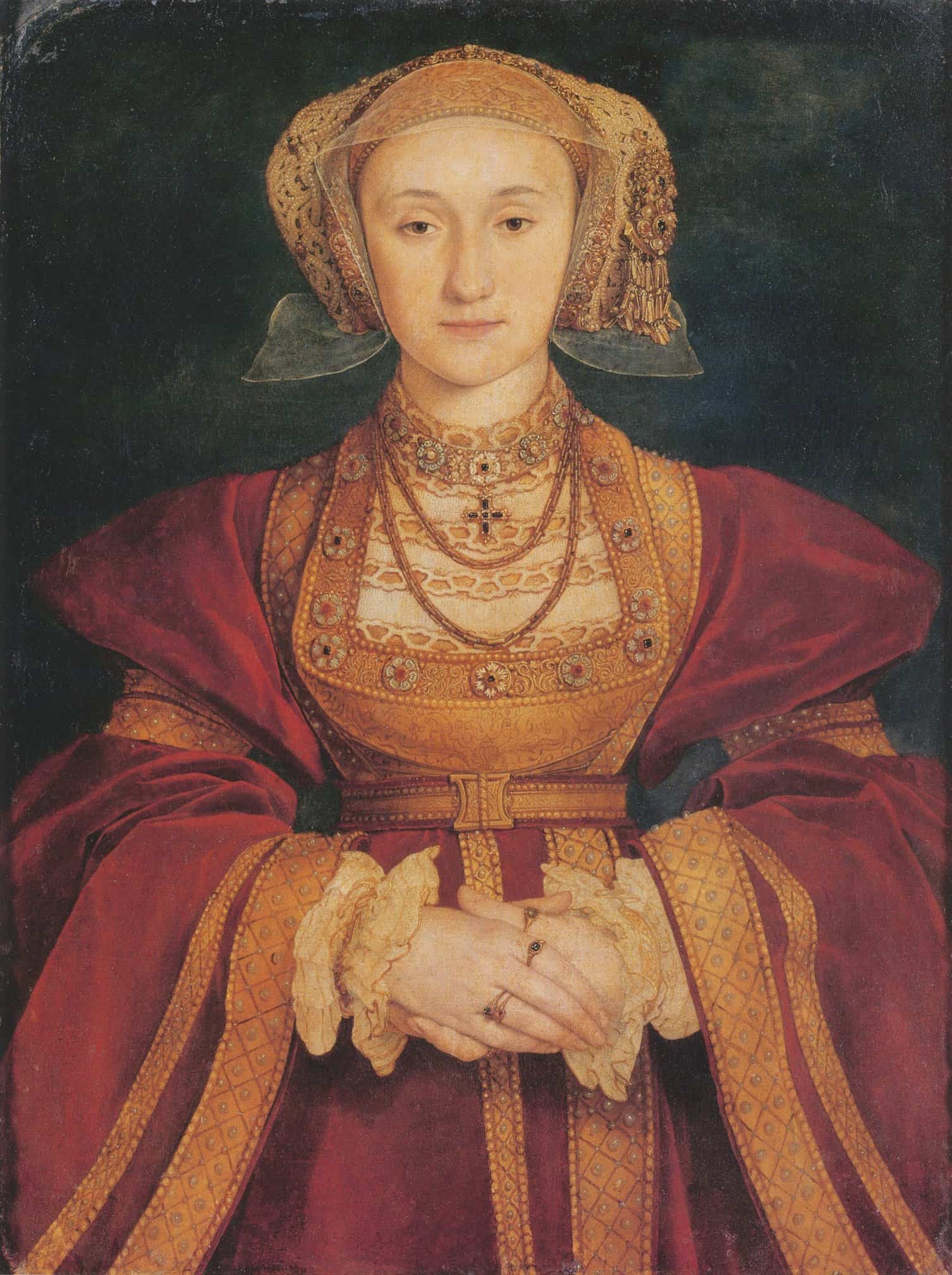Download Thomas Cromwell Worksheets
Do you want to save dozens of hours in time? Get your evenings and weekends back? Be able to teach Thomas Cromwell to your students?
Our worksheet bundle includes a fact file and printable worksheets and student activities. Perfect for both the classroom and homeschooling!
Table of Contents
Add a header to begin generating the table of contents
Summary
- Thomas Cromwell’s humble origins
- Cromwell as an adviser to Cardinal Wolsey
- King’s chief minister and his role in the English Reformation
- Downfall and death
Key Facts And Information
Let’s know more about Thomas Cromwell!
- Thomas Cromwell was born into a poor family in Putney. He left home at a young age, and travelled to Europe. This allowed him to meet interesting people and enrich his cultural formation and education. His intelligence, industriousness and good connections made him one of the most prominent men of Henry VIII’s reign and the English Reformation. Although his spectacular rise to power was followed by his spectacular downfall, he is still admired for how he helped bring about political and religious changes in England.
Humble Origins
- Thomas was born to Walter Cromwell and Katherine née Meverell in Putney (London) in 1485. He was the youngest of three children.
- Although his family owned a brewery, his parents carried out several jobs. His father was not committed to any job in particular, instead carrying out all sorts of trades: he was a fuller, a blacksmith, a brewer and a tavern owner.
- His father was not an honest person: he got into trouble by diluting the beer he produced with water, assaulting his neighbours, and falsely altering documents regarding his tenure, which caused his eviction from manorial tenancy in 1514.
- Having had enough of the environment he was born into, as well as of his father’s less admirable traits, in around 1503 Cromwell left home for the Netherlands and then went onto France from there.
- Thomas joined the French Army during the battle against the English. Years later, he fought in Naples in the Battle of Garigliano where the French army was defeated by the Spanish. As a consequence, he deserted the battlefield and travelled across Italy instead.
- Thomas became penniless and while begging for alms in the street, he was noticed by the powerful Florentine merchant banker, Francesco Frescobaldi. Frescobaldi (who belonged to a prominent noble family) believed the young Englishman had much potential and employed him.
- Thomas demonstrated his devotion to the Frescobaldi family and their business.
- During this time, Thomas gained invaluable experiences and enriched his cultural formation while living in a comfortable household and being surrounded with the finest Renaissance works.
- When he parted with Frescobaldi, he was gifted with sixteen gold ducats and a strong horse. Afterwards, he worked as an accountant for a Venetian trader.
- Thomas took several jobs while travelling to key centres of trade in parts of Europe.
- He learnt to communicate in different languages: French, Italian, Spanish, Latin, Greek and possibly German.
- Thomas’ years abroad made him a cultured and thriving merchant with good connections.
- Upon his return to England in 1514, he married Elizabeth Wykys, whose family held a favourable position within society. He worked as a business agent while serving his father-in-law’s house as a wool and cloth merchant.
- He had not neglected his education and dedicated himself to the study of law.
- Thomas and Elizabeth’s union gave birth to their three children: daughters Anne and Grace, and a son, Gregory. Their family lived in Fenchurch, an area which was often visited by merchants and meant easy access to Thomas’ business affairs.
- Elizabeth, Anne, and Grace are believed to have died of sweating sickness in 1529.
- In 1517, Thomas left again for Italy, although he quickly returned to England. An acquaintance asked for assistance to secure permission from the Pope to sell indulgences on behalf of Boston’s Guild of Our Lady in St. Botolph’s Church. His actions to secure the grant impressed the pope and were ultimately successful.
- During his travel in 1517-18, Thomas learnt the Latin translation of the New Testament, which Erasmus had recently published.
Adviser to the Cardinal
- In 1518, upon Thomas’ return from Rome, he gained prominence, working for Thomas Cardinal Wolsey, who was one of Henry VIII’s most trusted men and First Minister.
- Wolsey was working on creating a legacy project: in fact, in 1520 Thomas was responsible for gathering Italian sculptors that could build the cardinal’s enormous tomb.
- Both of humble origins, there is no doubt about how Wolsey and Thomas established a close alliance – their wisdom, intelligence and industriousness took them far from where they started.
- By the middle of 1522, Thomas had improved in status and wealth, as well as gained a reputation as a lawyer, thanks to the outcomes of Wolsey’s influence.
- In 1525, Wolsey appointed Thomas in the dissolution of monasteries and small religious houses that were converted for the use of Cardinal’s College at Oxford and for the funding of the college and foundation of Wolsey’s grammar school in Ipswich.
- In 1529, Thomas became a Member of Parliament (more precisely, of the House of Commons) when Wolsey fell from power because of his failure to gain the Pope’s permission to terminate King Henry VIII’s marriage to Catherine of Aragon.
- Despite the fact that everyone turned against Wolsey, Thomas always remained faithful to his mentor. His reputation was so closely tied to Wolsey’s that he was distraught and worried to lose a decade of his hard work.
- It was the cardinal’s death that propelled Thomas to undertake more royal administrative and legal duties, and by the end of 1530, he joined the king’s council.
King’s chief minister and the English Reformation
- Thomas joined the king’s service in 1530. His appointment to the council gained him exclusive access to the king and thrust him into the king’s circle of trusted advisers.
- He accumulated a collection of offices and position in the government.
- Thomas drafted the bill which the parliament passed into law as the Act of Restraint of Appeals in 1532.
- The law gave the king the final legal authority in all matters in England, Wales, and other English possessions, and prevented all appeals to the Pope in Rome on religious and other matters.
- This law made sure that the king’s marriage would not be challenged in Rome which made way for the divorce of King Henry VIII’s marriage with Catherine of Aragon, and for the lawful pronouncement of the king and Anne Boleyn’s marriage in 1533.
- In 1534, the Act of Supremacy was passed when Thomas was authorised by the king to enact the legislation necessary to completely break England’s remaining ties with the Church of Rome.
- This act claimed the king of England full ecclesiastical authority, nominating him as the Head of the English Church.
- Queen Anne Boleyn grew furious that the proceeds of these commissions were not to be used for charitable purpose.
- By that time, Henry VIII discussed with his advisers the possibility of divorce from Anne Boleyn. The king was already interested in Jane Seymour.
- Acting with the king’s authority and recognising Boleyn as a threat to his position, Thomas brought an end to Anne Boleyn’s trial. Anne Boleyn was accused of treason and adultery, and as a consequence, was beheaded together with her closest supporters in 1536.s
- In 1535, Thomas planned the Dissolution of the Monasteries and the visitations to the universities and colleges, which led to the destruction of library collections deemed superstitious.
- With the help of Thomas Cranmer and plans of radical evangelical reforms, he attempted to introduce the Ten Articles, two sets of royal injunctions, and the introduction of English Great Bibles.
- Thomas became the main target of those who participated in the Pilgrimage of Grace. Nevertheless, he succeeded in discrediting his religious and political opponents resulting in the judicial killing of Courtenay and the Pole families.
- Jane Seymour was the king’s third wife and gave birth to Henry’s son, Edward VI.
- Queen Jane died during childbirth, and only a week later, Thomas was assigned the duty of travelling around Europe in order to find a new wife for the king.
- Thomas desired to establish diplomatic relations with the Protestants. Therefore he travelled to Germany and designated Anne of Cleves as one of the possible women Henry could marry.
- Even the German painter Hans Holbein the Younger gave an unrealistic representation of the king’s future wife, by representing her as a gracious, delicate, doll-faced girl.
- Henry VIII was largely unimpressed during his first encounter with Anne of Cleves.
- Although he was completely repulsed by Anne of Cleves, Thomas convinced the king to go ahead with the marriage in order to strengthen England’s relation with Protestantism.
Downfall and Death
- Thomas fell out of the king’s graces when he brought about the disastrous marriage of the king and Anne of Cleves in pursuit of possible alliance.
- Following his union with Anne of Cleves, Henry VIII was disappointed in Thomas since he felt he had been tricked and fooled.
- Thomas’ conservative enemies, Thomas Howard, duke of Norfolk, and Stephen Gardiner, bishop of Winchester, persuaded the king of Thomas’ treachery and heresy. The king’s annulment to Anne of Cleves, which was based on non-consummation, also humiliated the king.
- Therefore, although Hans Holbein the Younger was simply dismissed from his position as royal painter, Thomas, on the other hand, was accused of various charges.
- One of Thomas’ last letters to Henry VIII states: ‘Most gracious Prince, I cry for mercy, mercy, mercy!’
- Stripped of his titles and property, the king’s most loyal servant was executed without trial on 28 July 1540 on Tower Hill.
- The same day, Henry VIII married Catherine Howard. The king regretted his hasty decision of Thomas Cromwell’s killing later on.
Image sources:
[1.] https://upload.wikimedia.org/wikipedia/commons/c/c6/Cromwell%2CThomas%281EEssex%2901.jpg

